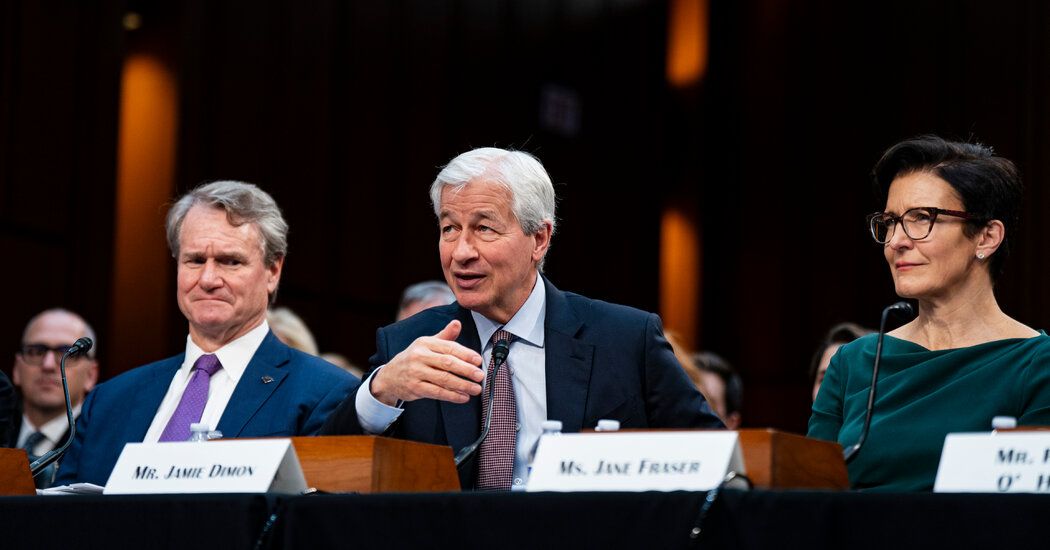The nation's largest banks are making profits as interest rates remain high, even though lenders have had to set aside billions of dollars to replenish a deposit insurance fund that was badly depleted by a crisis between medium-sized banks last spring.
Fourth-quarter 2023 earnings reported Friday by JPMorgan Chase, Bank of America and Wells Fargo topped analyst expectations, and the banks, which together account for about a third of all Americans, each reported that his customers had continued spending.
Citigroup, which is in the midst of a global restructuring, reported a net loss of $1.8 billion for the quarter, compared with a profit of $2.5 billion a year ago. The bank had warned that extraordinary expenses stemming from its efforts to withdraw from countries such as Russia and Argentina were proving costly. On Friday, it revealed plans to cut about 10 percent of its workforce as part of a restructuring that its chief executive, Jane Fraser, described at length last fall.
In the final quarter of 2023, JPMorgan earned $9.3 billion, or $3.04 per share, compared with $11 billion a year earlier. A special assessment by the Federal Deposit Insurance Corporation had reduced earnings per share by 74 cents, the bank said. Analysts had expected earnings per share of around $3.32, so investors considered the bank's performance a win once the one-time $2.9 billion FDIC bill was taken into account.
The bank's revenue for the quarter was $38.6 billion. Compared to the same period last year, revenue increased 12 percent.
Unlike his counterparts at Bank of America and Wells Fargo, who seemed optimistic about the U.S. economy, JPMorgan CEO Jamie Dimon warned that political leaders and investors may be underestimating the economic pain ahead.
In a statement released alongside the bank's earnings report, Dimon listed wars in Ukraine and the Middle East, the overhaul of U.S. infrastructure and rising health care costs as “significant and somewhat meaningless forces.” precedents” that could cause inflation (and, therefore, interest rates). stay above what investors are prepared for at the moment.
Asked Friday why the bank was forecasting six rate cuts in 2024, while Dimon's statement seemed to suggest something different, JPMorgan Chief Financial Officer Jeremy Barnum said the bank used modeling to predict the rate cuts. . “Beyond that, everyone has different opinions on fees, and they should.”
Consumers and businesses faced the highest interest rates in more than 20 years as the Federal Reserve works to control inflation. Rising rates triggered a crisis last March among midsize banks, causing three lenders to go bankrupt and a fourth to dissolve. Federal officials tapped the government's deposit insurance fund to recover depositors from two of the failed institutions, and are now raising about $16.3 billion to replenish the fund, hoping the biggest banks will pay the most. .
Bank of America's profits fell this quarter as it paid a $2.1 billion special contribution to the government fund that absorbs the cost of bank failures. It also recorded a $1.6 billion charge related to the discontinuation of the Bloomberg Short-Term Bank Yield Index, a benchmark rate it adopted to replace the also discontinued London Interbank Offered Rate. That accounting adjustment will be reflected in subsequent quarters; The bank plans to include $1.6 billion in its interest income in the coming years.
Including those costs and adjustments, the bank reported a profit of $3.1 billion for the quarter on revenue of $22 billion, down from a profit of $7.1 billion a year ago on revenue of $24.6 billion. Dollars.
Brian Moynihan, the bank's chief executive, described the quarter as “solid” and praised the bank's “good loan demand” and growth in customer deposits. These have risen steadily after turmoil last year caused by regional bank bankruptcies and rising interest rates that led investors to seek higher yields. Bank of America's average deposits this quarter totaled $1.9 trillion, just slightly below its average from a year ago.
Wells Fargo earned $3.4 billion on revenue of $20.4 billion, both up from the previous year. The bank paid a fee of $1.9 billion to the government fund and recorded $969 million in severance costs it expects to incur this year. It has not offered an estimate on how many jobs it plans to cut, and Michael Santomassimo, the bank's chief financial officer, said the reductions would be spread widely across the bank. He attributed the cuts to “efficiency work we're doing across the company.”
High interest rates have helped boost banks' profits, and executives are bracing for the effects if the Federal Reserve, as expected, cuts rates. Wells Fargo said its net interest income could fall at least 7 percent this year. Charlie Scharf, the bank's chief executive, said the bank was “sensitive” to interest rates and the overall health of the U.S. economy, but struck an optimistic tone and said credit quality remains strong, a sign of resilience. of the consumer.
Citigroup's net loss included a $1.7 billion FDIC bill and an addition to the bank's loss reserves to prepare for risks in Russia and Argentina, as well as the hit from the sudden devaluation of the Argentine peso. Over the next two years, the bank plans to eliminate around 20,000 jobs out of a total of 200,000.









